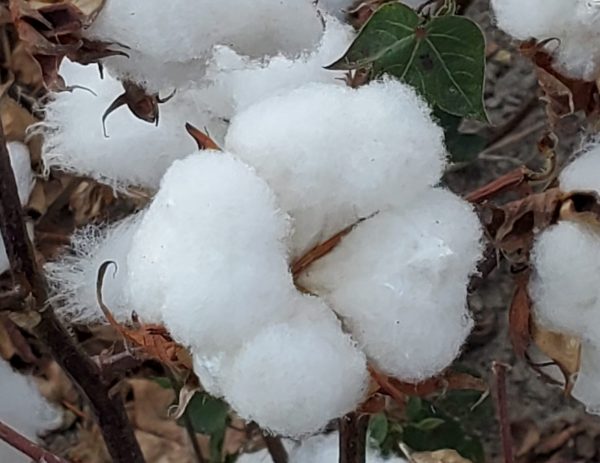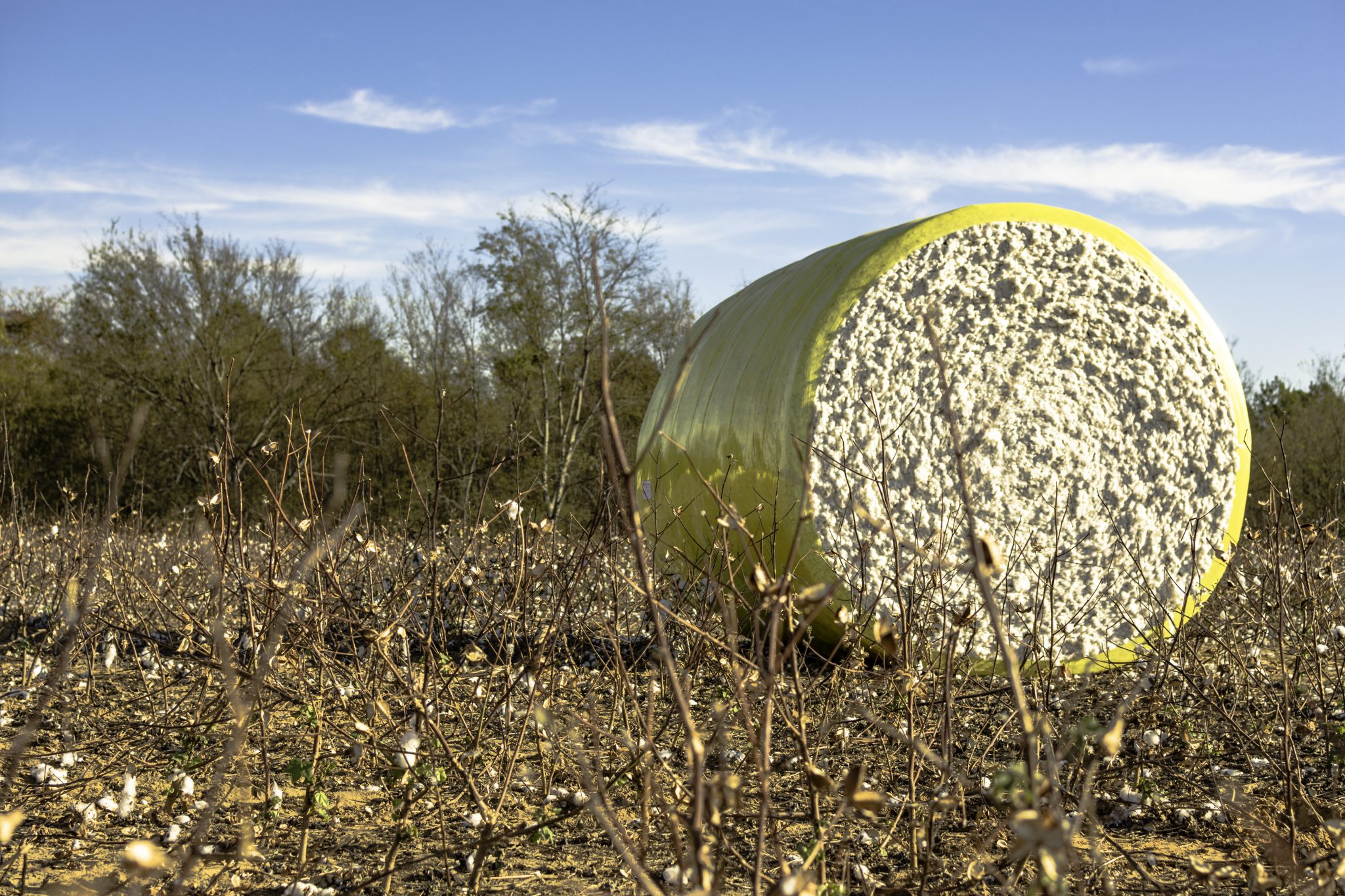Crop Production

Cotton has long been appreciated for its comfort, feel, absorption, breathability, and versatility. Today, at least a dozen countries are major producers of cotton. The crop is traded internationally in markets in New York, China, India, Pakistan, and the Far East. US cotton is processed both in domestic mills and in mills around the world. As much as 80 percent of the US crop is exported.
While yield is the big number that influences returns per acre, fiber quality affects the value of each pound of lint produced. This impacts bottom-line returns for producers as well as textile manufacturers.
Every cotton bale is evaluated for as many as eight different characteristics. The price per pound of lint is determined using these measurable features against a standard base set of qualities. The quality parameters of each bale of US cotton are determined by the USDA classing system. These data are recognized and accepted around the world.
Manufacturing Influences on Fiber Quality
Textile manufacturers historically have placed demands for certain aspects of quality. Manufacturing interests shift with the types of spinning equipment used, advancements in manufacturing processes, and the intended product.
Cotton fibers technically are trichomes, or hairs. Generations of breeding have developed varieties that concentrate production into fibers with desirable qualities of color, length, strength, and density. Fiber that doesn’t meet a particular quality standard is subject to deductions, which result in a reduced price paid per pound of lint. Diminished quality is sometimes related to variety choice, in-season management, defoliation, delayed harvest, or gin practices; oftentimes, however, there are causal factors beyond a producer’s control.
Premiums are offered for fiber that is above standard grade. Occasionally, a given quality parameter is specifically needed in the industry (for example, fiber strength or staple), and premiums reward these improvements. Some premium traits are associated primarily with genetics (for example, length and strength), while others are linked to favorable conditions at harvest (for example, color). Premiums for a singular desirable trait frequently are paid only for a couple of years and lessen as the favored property becomes “standard.”
The bottom line: Growers should do everything possible to avoid deductions, strive for premiums, and not be surprised when premiums for a specific property moderate or disappear after a few seasons.
Fiber Development Process
Farming and ginning practices can preserve but not create superior fiber quality. As a field crop, cotton is subject to biological, environmental, genetic, and management effects that influence lint production and quality. Fibers also vary by growing location (in the canopy, on a fruiting branch, within the boll, or within a lock) and even by the initiation point on a seed.
A fiber is a single cell that originates as a little bump on the seed surface. Each bump elongates to form and fill a straw-like tube, which ultimately becomes a harvested fiber (attached to the seed in the form of seed cotton) and later separated as lint through ginning. Fibers per seed range from 13,000 to 20,000. Each healthy lock typically contains six to nine seeds. The most common number of locks per boll is four, though five- and three- lock bolls occur occasionally. A pound of ginned cotton may contain 100 million individual fibers.
The two significant phases of fiber development are elongation and fill. Elongation begins the day of flowering, with fibers originating first from the rounded portion of the seed (chalazal region) and a couple of days later from the pointed end (micropylar). Additional short fibers (those that become fuzz or linters) generate 5 to 10 days after bloom. Elongation continues for about 20 days, resulting in fibers varying in length from 0.75 inch to almost 1.5 inches.
About 15 to 20 days after fiber initiation, cellulose deposition begins on the inside of a formerly hollow, straw-like cell, adding weight, strength, and density to each fiber. Deposition of these intertwining, secondary walls of cellulose continues for 40 to 45 days until the boll is mature and ready to open. Because of the nature of cotton growth and fruiting patterns, bolls are at varying developmental stages throughout the latter part of the season. This results in a mingling of fibers with slightly varying properties in a harvested and ginned bale.
Cotton fiber development does not replicate the uniformity and consistency achieved in manufacturing man-made fibers. However, man-made fibers do not possess all the preferred properties of cotton.
Fiber Assessment
Motivated by a long-recognized need for equitable standards, US legislative authorities created the USDA classing system in the 1920s. The system has been refined and modernized and currently processes up to 20 million bales annually in ten offices across the Cotton Belt. Alabama cotton from the northern regions is classed in Memphis, Tennessee, while the remainder of the state’s crop is sent to the USDA Classing Office in Macon, Georgia. These two facilities class a significant portion of the US crop each year.
The goal of the USDA classing system is to provide a consistent, quantifiable description of every bale of US cotton so that growers, merchants, and textile manufacturers have an accurate, dependable determination of its properties and value. The USDA classing system is recognized globally as the standard for quality assessment.
In the gin press where each bale is pressed, weighed, and wrapped, small portions (about 4 ounces) of lint are cut from opposite sides of each bale. The bale with its collective sample is assigned a permanent bale ID number, and a sample is shipped to a USDA classing office, where it is conditioned to a standard humidity and then subjected to analysis in precision equipment referred to as HVI (high volume instrumentation). Specific HVI determinations are made for color, length, micronaire, strength, uniformity, leaf grade, and trash. Human inspectors or classers also visually examine each sample for extraneous matter; this is a broad category used to identify and quantify several undesirable features. See table for sources of fiber quality effects and variations.
Table 1. Sources of Fiber Quality Effects and Variation
| Fiber Property | Variety | Environment/Management | Ginning |
|---|---|---|---|
| Color grade | Yes | Yes | |
| Staple | Yes | Yes | |
| Micronaire | Yes | Yes | |
| Strength | Yes | Yes | |
| Length uniformity | Yes | Yes | |
| Leaf and trash | Yes | Yes | Yes |
| Extraneous matter | Yes | Yes |
Color Grade
Color grade is a measurement of reflectance (brightness or dullness) and yellowness of fiber. It is reported as a three-digit number, such as 41-4, which is the current base grade. These numbers fall into ranges of traditional categories, such as good middling, strict low middling, and below grade, and are generally described as white, light spotted, spotted, tinged, and yellow stained grades.
The lower the grade number the better; for example, grades 31-4 or 21-1 are superior to the base grade 41-4 mentioned previously. Elevated numbers, such as 42, 52, or 62, indicate a dullness of color and typically result from weathering. Reduced color diminishes dyeing properties of fibers and also negatively affects spinning efficiencies.
Color is most often influenced by weather conditions during the last weeks of the growing season through the picking process and to a lesser extent by harvest aids. Color also can be reduced by poor conditions in module storage. With prevailing dry, open weather, proper defoliation, and timely harvest, cotton is bright and white, and grades consistently are 31 or better. As the crop is exposed to repeated rainfall, color darkens, and grade and value decline.
Staple
Staple refers to fiber length and is the average length of the longest 50 percent of the fibers in a sample. It also is referred to as the upper half mean length (UHM). It is reported in 32nds or 100ths of an inch. Current base grade for staple is 34, which is 34/32 of an inch or 1.06 inches. Longer fiber enhances yarn strength, consistency, fineness, and spinning efficiency. Genetics significantly influence fiber length, but moisture and temperature stresses as well as nutrient deficiencies and harsh ginning also can adversely affect staple.
Micronaire
 Micronaire (mic or mike) is a determination of fiber fineness and sample density in a cross section, and it partially reflects fiber maturity. It is measured by forcing air through a standard weight and volume of fibers. The mic range includes premium, base, and discount levels. Deductions occur for low and high mic. Low mic is 3.4 and below; a premium is paid for 3.7 to 4.2; high mic is anything above 4.9.
Micronaire (mic or mike) is a determination of fiber fineness and sample density in a cross section, and it partially reflects fiber maturity. It is measured by forcing air through a standard weight and volume of fibers. The mic range includes premium, base, and discount levels. Deductions occur for low and high mic. Low mic is 3.4 and below; a premium is paid for 3.7 to 4.2; high mic is anything above 4.9.
Mic is determined greatly by genetics (variety) but is also affected by environmental factors. Hot, dry conditions often reduce boll set. This concentrates production (cellulose deposition) in a limited number of bolls and results in elevated mic.
High mic (in the discount range) is far more common in Alabama than is low mic. In areas of the Cotton Belt with a short growing season, premature crop termination often results in low mic. Immature fibers (low mic) are undesirable from the standpoint of reduced strength, spinning efficiency, and dyeing; overly dense fibers (high mic) also may create challenges in dyeing. Because high mic means additional weight per fiber, it is often a desired selection trait for cotton breeding. However, mic 5.0 and greater receive deductions in the marketplace.
Strength
Strength is simply the force required to break a certain volume of fibers. It is reported in g/tex. Fiber strength significantly affects spinning efficiency and yarn strength. Strong fibers correlate to strong yarns. Genetics, crop management, and environment affect strength. Weathering in late summer and into the fall can result in significant declines in fiber strength. Base grade for strength is 26.0 to 28.9 g/tex. In the late 1980s and in the 1990s, DP 90 was a preferred cotton from the Southeast because of its high fiber strength and consistent yield.
Length Uniformity
Length uniformity index (LUI) is a ratio of the overall average fiber length to the average length of the longest 50 percent of fibers (the UHM). If all fibers are identical in length (which is never the case), the LUI is 100. Uniformity ranges from the upper 70s to mid-80s, and base grade is 80.0 to 81.9.
LUI indirectly measures short fibers (less than 0.5 inch). Short fibers create inefficiencies and inconsistencies in yarn spinning. Historically, DP 555 BR, a variety which dominated plantings in the lower Southeast in the mid- to later 2000s, had specific issues with short fiber content as reflected by LUI.
Leaf Grade and Trash
Leaf grade and trash indicate the level of non-lint particles in a sample. They are determined by a digitized examination of the surface area of a sample. The scale is 1 to 7, with the lower numbers indicating less trash. Leaf, bark, and small “pepper” trash are difficult to remove from lint and create significant challenges at the gin and mill. Variety, defoliation, harvest conditions, and ginning all affect leaf and trash in cotton.
Extraneous Matter
Extraneous matter is a broad category of discounts evaluated by the human eye rather than HVI. Human classers examine lint samples for bark, seed coat fragments, grass, oil, spindle twist, plastic, whitefly stickiness, and “prep” (roughness of finish).
Bark occurs as cotton stalks deteriorate and the spindle action of pickers strips fragments of bark tissue into the harvested crop. Bark typically increases as harvest season progresses past a significant frost or freeze, causing cotton stalks to weather and lose integrity. Seed coat fragments occur as spindle picking and/or ginning grinds seed into the lint fraction. In 2020, the crop in the lower southeast and much of the southern two-thirds
of Alabama had unprecedented (40 percent) seed coat fragments, costing the state’s growers about $4 million in fiber quality deductions. The problem was associated with the lingering effects of Hurricane Sally, which came ashore along the Gulf Coast on September 16, 2020, and was followed by 2 to 3 weeks of rain, overcast conditions, warm temperatures, and high humidity.
Plastic occurs as a contaminant when shopping bags, plastic bale wrap, and plastic twine are pulled into the picker and follow through to the gin and bale. Penalties for plastic are among the most severe deductions in the market. These and other extraneous materials are extremely difficult to remove at both the gin and textile mill.
Why Fiber Properties Matter
Fiber characteristics affect textile manufacturing processes as well as intermediate and finished goods such as yarn, fabric, and final products. Raw cotton represents a majority portion of the cost of textile production; thus, the most scrutinized fiber property is price.
Mills have preferences for specific characteristics based on machinery and intended product. To improve efficiency and consistency, mills employ a sophisticated process of blending bales of varying qualities. This blending process allows mills to use cotton across a range of qualities, providing a home for most of the cotton produced in the United States.
Growers obviously want to avoid discounts and capture premiums for above-average fiber quality when growing conditions and market forces allow. Every penny counts. For example, assume cotton is selling for 60 cents per pound. A 900-pound per acre yield generates a per-acre value of $540 with standard (base) grade. If conditions or management result in a 2.5 cents per pound quality deduction, per-acre income declines to $517; conversely, with a 2.5 cents per pound premium, revenue increases to $562.
Reputation also can matter, both collectively and individually. For example, if a gin or part of the state is recognized for delivering consistently high-quality cotton, they will be a preferred supplier for buyers and mills. Sometimes this past record may even provide an advantage during times when their quality data are not significantly better than other areas. The opposite is also true. Suppose a gin or region of the state repeatedly has trouble with bark or whitefly discoloration and stickiness; their market opportunities could shrink. Or, if a textile mill has problems with plastic contamination, the problem can be linked to a gin and grower through the bale ID number, and repercussions likely will follow.
Demand for below-standard quality is weak, and thus poor-quality cotton typically garners a reduced price. Discounts could be even greater if there is
an abundance of low-quality cotton. The market often discriminates severely for certain unfavorable parameters. Cotton with good overall properties but with a particular blemish is sometimes strongly preferred but still discounted. Cheap cotton is a favored choice for buyers, assuming that the cotton can still fit in the production process. Unwanted quality ultimately finds a home, but usually at unwanted prices for the grower. Good quality ensures that a bale of cotton will always have a market.
Resources
Cotton Incorporated (www.cottoninc.com/fiber/quality/). This website is an excellent source of overall fiber quality information as well as specific reports for quality of the current and recent crops.
Cotton: Origin, History, Technology, and Production by C. W. Smith and J. T. Cothren (1999).
 Steven Brown, Extension Specialist, Assistant Professor, and Tyler Sandlin, Assistant Extension Professor, Assistant Research Professor, both in Crop, Soil, and Environmental Sciences, Auburn University.
Steven Brown, Extension Specialist, Assistant Professor, and Tyler Sandlin, Assistant Extension Professor, Assistant Research Professor, both in Crop, Soil, and Environmental Sciences, Auburn University.
Revised April 2022, How to Think About Fiber Quality in Cotton, ANR-2637

